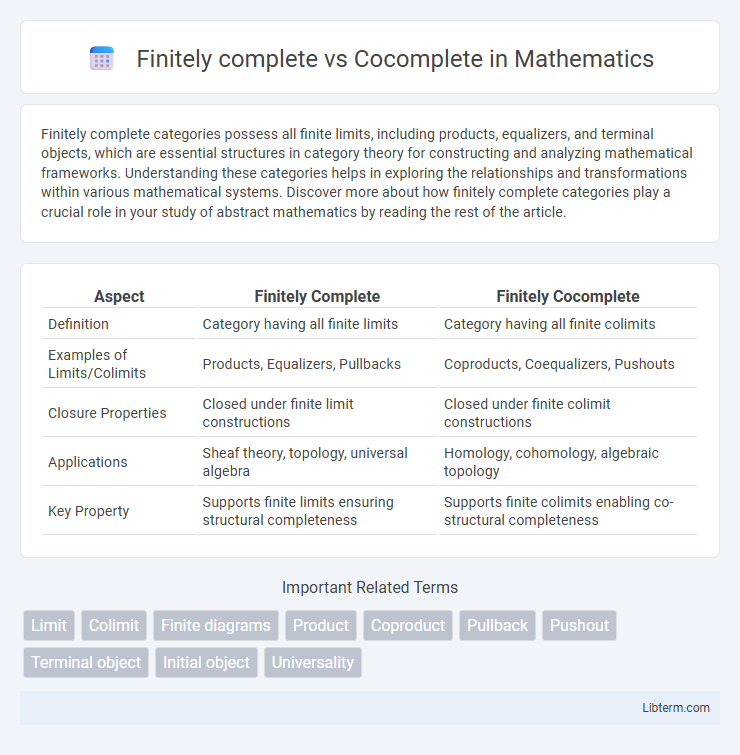Finitely complete categories possess all finite limits, including products, equalizers, and terminal objects, which are essential structures in category theory for constructing and analyzing mathematical frameworks. Understanding these categories helps in exploring the relationships and transformations within various mathematical systems. Discover more about how finitely complete categories play a crucial role in your study of abstract mathematics by reading the rest of the article.
Table of Comparison
| Aspect | Finitely Complete | Finitely Cocomplete |
|---|---|---|
| Definition | Category having all finite limits | Category having all finite colimits |
| Examples of Limits/Colimits | Products, Equalizers, Pullbacks | Coproducts, Coequalizers, Pushouts |
| Closure Properties | Closed under finite limit constructions | Closed under finite colimit constructions |
| Applications | Sheaf theory, topology, universal algebra | Homology, cohomology, algebraic topology |
| Key Property | Supports finite limits ensuring structural completeness | Supports finite colimits enabling co-structural completeness |
Introduction to Finite Completeness and Cocompleteness
Finite completeness in category theory refers to the existence of all finite limits, including products, equalizers, and pullbacks, enabling the construction of universal objects that satisfy certain finite diagram constraints. Finite cocompleteness involves the presence of all finite colimits, such as coproducts, coequalizers, and pushouts, which facilitate the combination and identification of objects within a category. Understanding these foundational properties is crucial for analyzing categories' structural behavior and their ability to handle finite diagrammatic constructions.
Defining Finitely Complete Categories
Finitely complete categories are those that possess all finite limits, including products, equalizers, and terminal objects, enabling the construction of universal cones for finite diagrams. These categories support the formation of pullbacks and finite products, ensuring the existence of limits critical for defining structures such as kernels and intersections. Understanding finitely complete categories is essential in category theory for modeling finite information or constraints within a categorical framework.
Understanding Cocomplete Categories
Cocomplete categories are those that have all small colimits, including coproducts, coequalizers, and pushouts, enabling the construction of objects through universal cocones. Understanding cocomplete categories involves recognizing their role in generalizing the idea of combining structures and the existence of colimits necessary for categorical constructions. In contrast, finitely complete categories only require the existence of finite limits, such as products and equalizers, which focus on limiting processes rather than colimiting ones.
Key Differences Between Finitely Complete and Cocomplete
Finitely complete categories have all finite limits, including products and equalizers, ensuring the existence of universal constructions like pullbacks and terminal objects. Finitely cocomplete categories possess all finite colimits, such as coproducts and coequalizers, enabling the formation of universal constructions like pushouts and initial objects. The key difference lies in the type of universal constructions they guarantee: limits for finitely complete and colimits for finitely cocomplete categories.
Examples of Finitely Complete Categories
Examples of finitely complete categories include the category of sets, where all finite limits such as products and equalizers exist, and the category of groups, which supports finite limits including kernels and pullbacks. The category of topological spaces also exhibits finite completeness with limits like finite products and equalizers preserving topological structure. These categories demonstrate finite completeness by allowing constructions that capture universal properties for finite diagrams, essential in categorical analysis and algebraic topology.
Examples of Cocomplete Categories
Cocomplete categories possess all small colimits, including coproducts, coequalizers, and pushouts, essential for constructing objects by "gluing" smaller pieces. Examples include the category of sets (Set), where coproducts correspond to disjoint unions, and the category of vector spaces over a field, which admits direct sums as coproducts and quotients as coequalizers. These structures enable versatile constructions in algebra, topology, and beyond, contrasting finitely complete categories focused primarily on limits such as products and equalizers.
Importance in Category Theory
Finitely complete categories possess all finite limits, enabling the construction of products, equalizers, and pullbacks critical for defining and analyzing complex structures within category theory. Finitely cocomplete categories, equipped with all finite colimits like coproducts, coequalizers, and pushouts, facilitate the assembly and decomposition of objects, essential for categorical colimit computations and universal property characterizations. The interplay between finite completeness and cocompleteness underpins fundamental categorical constructions and ensures the robustness of functorial mappings and representable functors in advanced mathematical frameworks.
Applications Across Mathematics
Finitely complete categories possess all finite limits, enabling construction of products, equalizers, and pullbacks essential for defining algebraic structures and solving equations in category theory. Finitely cocomplete categories have all finite colimits, such as coproducts and coequalizers, facilitating the study of disjoint unions, quotient objects, and cohomological constructions. These properties underpin applications across algebra, topology, and logic, where finite limits model constraints and finite colimits capture gluing or identification processes.
Common Misconceptions
Finitely complete categories have all finite limits, including products and equalizers, while finitely cocomplete categories contain all finite colimits such as coproducts and coequalizers. A common misconception is that finite completeness implies finite cocompleteness or vice versa, but these properties are independent and may not coexist in the same category. Understanding the distinction is crucial for correctly applying categorical constructions and avoiding errors in theoretical or practical contexts.
Summary and Further Reading
Finitely complete categories have all finite limits, including products, equalizers, and terminal objects, while finitely cocomplete categories possess all finite colimits, such as coproducts, coequalizers, and initial objects. Understanding the distinction between finite completeness and cocompleteness is crucial for studying categorical constructions and their dualities. For further reading, consult Mac Lane's *Categories for the Working Mathematician* and Riehl's *Category Theory in Context* for comprehensive treatments of limits, colimits, and their categorical significance.
Finitely complete Infographic

 libterm.com
libterm.com